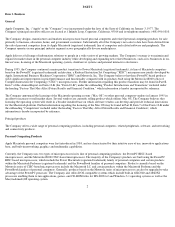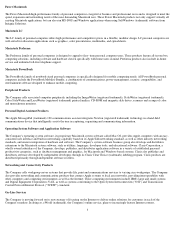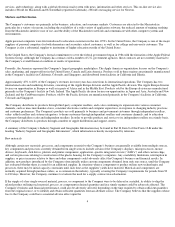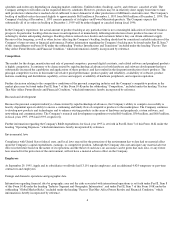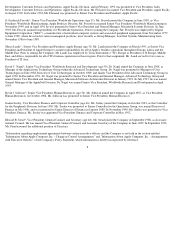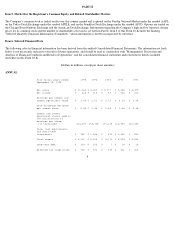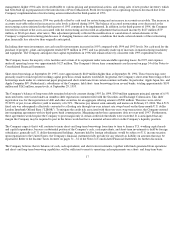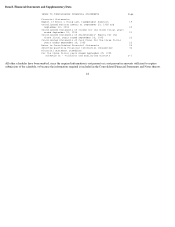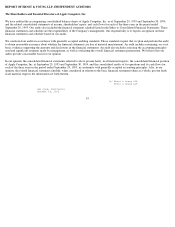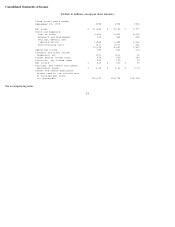Apple 1995 Annual Report Download - page 14
Download and view the complete annual report
Please find page 14 of the 1995 Apple annual report below. You can navigate through the pages in the report by either clicking on the pages listed below, or by using the keyword search tool below to find specific information within the annual report.increase in market share. The decrease as a percentage of net sales since 1993 is primarily a result of revenue growth during 1994 and 1995,
combined with the Company's ongoing efforts to manage total operating expense growth.
In 1994, selling, general and administrative expenses decreased in amount and as a percentage of net sales compared with 1993, primarily
because of lower employee-related and facilities costs resulting from the restructuring actions taken in the third quarter of 1993. Revenue
growth in 1994 also contributed to the decrease in selling, general and administrative expenses as a percentage of net sales.
The Company will continue to face the challenge of managing growth in selling, general and administrative expenses relative to gross margin
levels, particularly in light of the Company's expectation of continued pressure on gross margins and continued competitive pressures
worldwide.
Restructuring Costs
For information regarding the Company's restructuring actions, refer to pages 29 - 30 of the Notes to Consolidated Financial Statements.
Interest and Other Income (Expense), Net
Interest and other income (expense), net, decreased to $10 million in expense in 1995 from $22 million in expense in 1994. This $12 million
favorable change is comprised of $48 million in interest and other income attributable to higher average cash balances, higher interest rates,
and interest rate hedging gains, offset in part by a $36 million unfavorable variance related to realized and unrealized foreign exchange hedging
losses and foreign exchange hedging costs. Market volatility and higher foreign currency balances account for the increased hedging cost.
In 1994, interest and other income (expense), net, decreased to $22 million in expense from $30 million of income in 1993, resulting in a $52
million unfavorable change. Higher interest rates and larger average borrowing balances used to fund working capital needs served to
significantly increase interest expense, and accounted for $28 million of the $52 million change during 1994. Other factors contributing to this
variance included interest income, which was higher in 1993 than in 1994 primarily due to a $15 million interest payment received on a
nonrecurring income tax refund from the Internal Revenue Service in 1993, and interest income from the Company's interest rate risk
management program, which contributed $6 million in 1993, and reduced interest income by $7 million in 1994.
For more information regarding the Company's strategy and accounting for financial and other derivative instruments, refer to pages 26 - 28 of
the Notes to Consolidated Financial Statements.
Provision for Income Taxes 1995 Change 1994 Change 1993
Provision for income taxes $ 250 32% $ 190 258% $ 53 Effective tax rate 37% 38% 38%
The Company's effective tax rate decreased to 37% in 1995 compared with a rate of 38% in 1994 and 1993. For additional information
regarding income taxes, refer to pages 31 - 32 of the Notes to Consolidated Financial Statements.
Factors That May Affect Future Results and Financial Condition
The Company's future operating results and financial condition are dependent on the Company's ability to successfully develop, manufacture,
and market technologically innovative products in order to meet dynamic customer demand patterns. Inherent in this process are a number of
factors that the Company must successfully manage in order to achieve favorable future operating results and financial condition.
Product Introductions and Transitions
Due to the highly volatile nature of the personal computer industry, which is characterized by dynamic customer demand patterns and rapid
technological advances, the Company frequently introduces new products and product enhancements. The success of new product
introductions is dependent on a number of factors, including market acceptance, the Company's ability to manage the risks associated with
product transitions, the availability of application software for new products, the effective management of inventory levels in line with
anticipated product demand, and the manufacturing of products in appropriate quantities to meet anticipated demand. Accordingly, the
Company cannot determine the ultimate effect that new products will have on its sales or results of operations.
12


